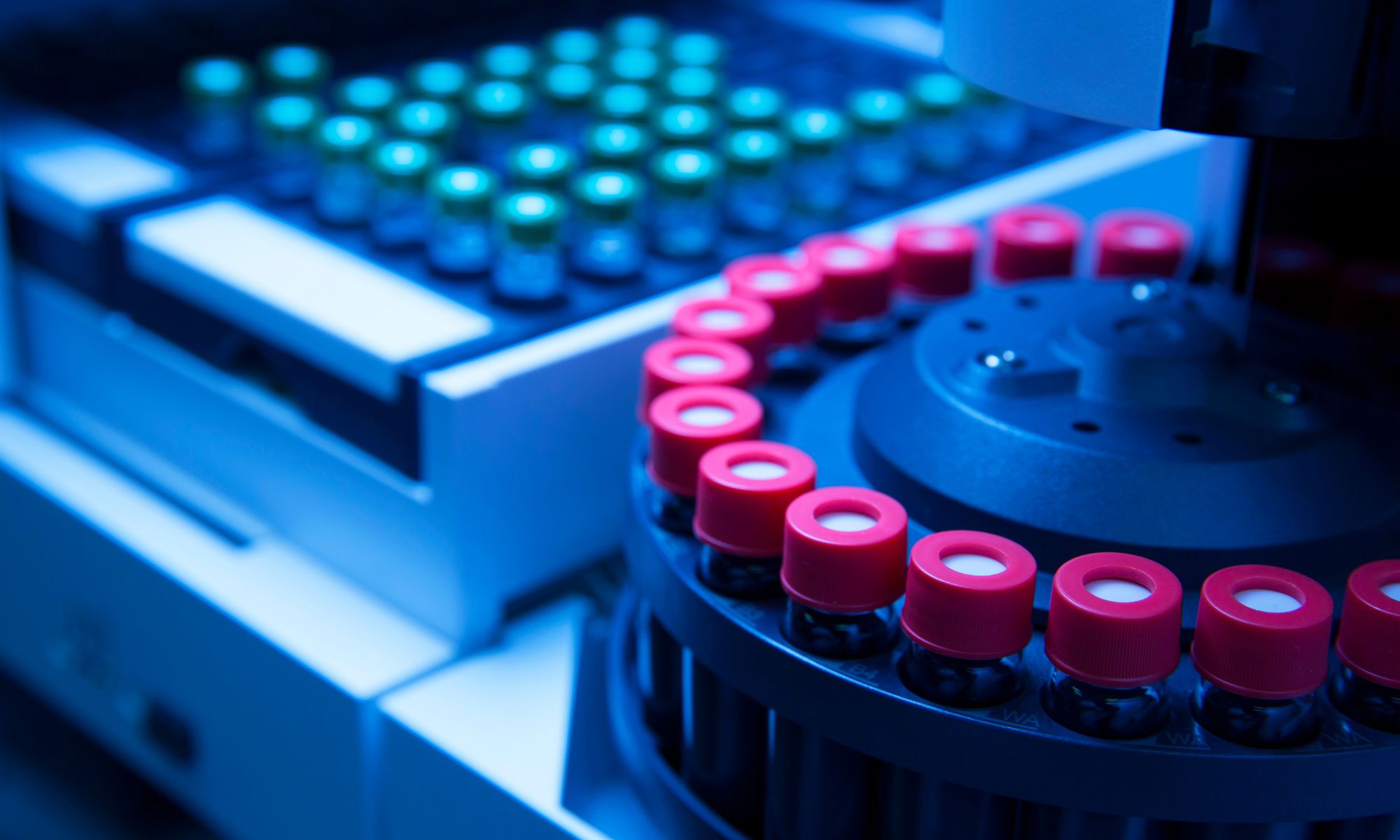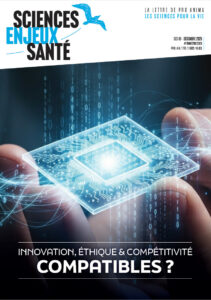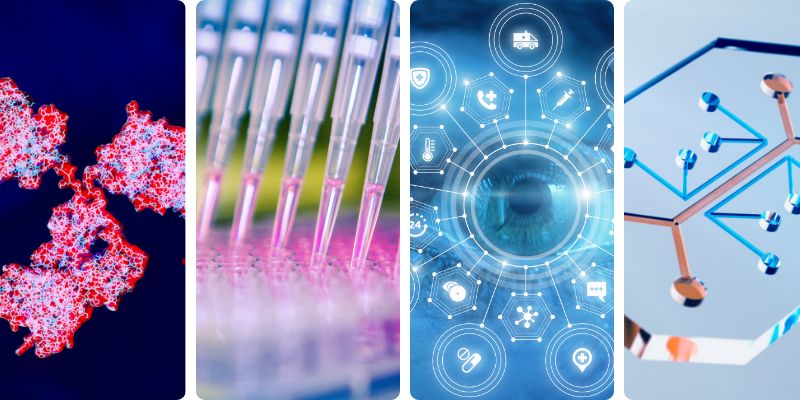
News on non-animal methods
OCTOBER 06 - 10, 2025
NEWS, REPORTS & POSITION STATEMENTS
1. OECD: Guidance on good practices and standardisation of omics data
Omics technologies are increasingly being used in regulatory toxicology as part of New Approach Methodologies (NAMs). These applications include identifying molecular points of departure for risk assessment, substantiating chemical grouping hypotheses, and measuring molecular key events predictive of adverse outcomes and associative events towards mode of action determination. However, ensuring the quality and reproducibility of omics data is critical for regulatory acceptance.
The OECD Guidance Document on good practices and standardisation of sample collection for omics analysis aims to enhance the reliability and regulatory acceptance of omics data by describing essential processes required to maintain sample integrity. The guidance applies primarily to three major omics approaches: transcriptomics, proteomics, and metabolomics.
2. Closing the Gap: How OOC are transforming women’s reproductive health research
Women’s reproductive health has historically been underserved in biomedical research. One major reason is that conventional preclinical models — animal studies and static cell culture — cannot capture the complex, hormone-responsive biology of the human female reproductive tract. As Dr. Donald Ingber once famously quipped, “mice don’t menstruate.”
Organ-Chip (OOC) models, also called microphysiological systems (MPS), are helping to close this critical gap by recreating human tissue microenvironments in a dynamic, microengineered platform. In a recent blog article, Emulate highlights three case studies — the Vagina-Chip, Cervix-Chip, and a new project focused on Uterus-Chips for heavy menstrual bleeding — that demonstrate how this technology is transforming women’s health research.
3. NAMs for DART: State of the art and applicability for cosmetic ingredients
The development of in vitro developmental and reproductive toxicity (DART) models is challenging. Several levels of complexity in pregnancy and embryo development, with different windows of susceptibility and biological variability, can make understanding of DART – and the development of relevant in vitro models — very complex.
In a recent review, Matthew Burbank from L’Oréal Research and Innovation and colleagues explored in silico models and provided an in-depth review of 17 established in vitro NAMs used to assess the DART potential of cosmetic-related ingredients. The researchers investigated the models’ coverage of the stages of male and female fertility and embryo-fetal development and related biomarkers, discussing and identifying potential gaps to support the next generation of risk assessments.
Read the review in NAM Journal
INTERVIEWS, NOMINATIONS & AWARDS
4. Biomedical research and innovation at a crossroads: Interview with Franck Mouthon and Jean-Dominique Guitton
The latest issue of Sciences, Enjeux, Santé, the French quarterly magazine dedicated to NAMs published by Pro Anima Scientific Committee, presents an exclusive double‑voice interview with two French leading figures in biomedical innovation: Jean‑Dominique Guitton, co-pilot of the French O&OoC sector (F3OCI) and Franck Mouthon, executive director of the Health Research Program Agency (APRS) entrusted to Inserm.
In this conversation, the experts explore the growing field of organoids and organs‑on‑a‑chip (O&OoC), and reflect on France’s strategic positioning amid a global race in health technologies, charting the scientific, technological, and regulatory hurdles that must be overcome for O&OoC to mature and be broadly accepted, while discussing the rapid advances in AI.
5. Nicole Kleinstreuer: Leading the NIH’s push to reduce the use of animals in biomedical research
In a recent interview with STAT, Nicole Kleinstreuer discusses her role leading the NIH’s (National Institutes of Health) new Office of Research, Innovation, Validation, and Application (ORIVA). She explains that ever since her early work in computational toxicology, she has believed there are better ways of predicting human health impacts than traditional animal tests. Acknowledging the challenges ahead (difficult disease domains, navigating criticism, political constraints), Dr. Kleinstreuer outlines ORIVA’s planned structure, and underscores that future funding will favor proposals rooted in human‑based models over those relying solely on animals.
“It wasn’t just a favorite childhood pet, or the fact that she cares deeply for animals, that led Nicole Kleinstreuer to help launch the National Institutes of Health’s initiative to scale back reliance on animals in research. It was also her love of numbers.”
6. Hans Clevers received the Spanish Abarca Prize
Hubrecht Institute announced that Hans Clevers, professor in Molecular Genetics at Utrecht University, interim Director and Head at Institute of Human Biology,received the Spanish Abarca Prize. Created in 2020 by the Fundación de Investigación HM Hospitales, the Abarca Prize recognizes the impact of medical-scientific advances and innovations, highlighting their importance for society.
“The work of Hans Clevers constitutes a pillar in the recent history of biomedicine. By discovering the Lgr5 marker and introducing gut organoid culture, he laid the foundation for a technology that today redefines biomedical research and clinical care”.
Read the announcement by Hubrecht Institute
TOOLS, PLATFORMS, CALLS
7. Biotech Act: European public consultation
The biotech sector plays a critical role in several areas of the EU economy. It is research-driven, fast-moving and requires substantial public and private investments.
The Biotech Act will propose a series of measures to create an enabling environment to accelerate the transition of biotech products from laboratory to factory and to the market, while maintaining the highest safety standards for the protection of the population and the environment.
The European Commission (EC) would like to hear stakeholders’ views. Inputs to the public consultation will be taken into account as the EC further develops and fine-tunes this initiative. The inputs received will be summarised in a synopsis report, explaining how the EC has taken it into account. The deadline to send feedback is 10 November 2025.
Read more and participate in the consultation
8. 2026 MPS World Summit: Call for abstract submissions
The MPS World Summit, organised by the International MPS Society, is the place to annually exchange, connect and educate about Microphysiological System (MPS) ‑cell culture systems replicating (patho-) physiology through engineered organ architecture and functionality-.
Abstract submissions for the 2026 MPS World Summit are now open. Abstracts are invited on the topic of new developments in MPS and applications of MPS, which are divided into four themes: 1. Engineering the Next Generation of MPS; 2. Modeling Human Biology with MPS; 3. MPS in Product Development; 4. Standards, Regulatory Pathways, and Global Adoption. Top-scored abstracts will be selected for an oral presentation at one of the scientific sessions. The submissions will be open until Sunday, January 11, 2026.
Read more and submit your abstract
INDUSTRY, BIOTECH & PARTNERSHIPS
9. Transcell Biologics, New Frontier Labs & 20/15 Visioneers: To advance non-animal approaches
Transcell Biologics, New Frontier Labs, and 20/15 Visioneers announced an interesting alliance aimed at pioneering non-animal New Approach Methodologies (NAMs). The collaboration will combine Transcell Biologics’ innovative offering, AI-enabled Digital Animal Replacement Technology, which leverages human MPS and wet lab science for real-time assessments, with New Frontier Labs’ expertise in drug discovery. 20/15 Visioneers is at the forefront of the global life sciences arena, serving as a dynamic facilitator of high-impact innovation and collaborations.
“This working agreement underscores the power of collaboration in reshaping the theme of translational science,” said John Conway, Founder & Chief Visioneer Officer, 20/15 Visioneers. “Together, we are enabling novel regulator-endorsed approaches that have the potential to reduce risk, shorten timelines, and supporting affordable breakthrough therapeutics.”
10. Helmholtz Munich & Parse Biosciences: Building the largest human lung tissue perturbation atlas
Helmholtz Munich and Parse Bioscienceshave launched a collaboration to generate an atlas of human lung tissue perturbations. The project uses Parse’s GigaLab single-cell sequencing platform to examine how healthy and diseased lung tissues respond to 900 different pharmacological interventions, aiming to map cellular circuits and uncover targets for future therapies and with the longer-term goal of informing precision therapies and regenerative strategies.
The initiative centers on ex-vivo lung tissue slice cultures derived both from healthy donor lungs and from patients with chronic lung disease. GigaLab reportedly enables the profiling of more than 10 million cells or nuclei in a single run and is built to handle billions of cells annually.
SCIENTIFIC DISCOVERIES & PROTOCOLS
11. Reproducibility of PD patient-specific midbrain organoid data for in vitro disease modeling
The 3D structure and multicellular composition allow disease research under more physiological conditions than is possible with conventional 2D cellular models. However, there are concerns in the field regarding the organoid batch-to-batch variability and thus the reproducibility of the results.
In a new manuscript, researchers generate multiple independent midbrain organoid batches derived from healthy individuals or glucocerebrosidase (GBA)-N370S mutation-carrying Parkinson’s Disease (PD) patients to evaluate the reproducibility of the GBA-N370S mutation-associated PD transcriptomic and metabolic signature as well as selected protein abundance. Their analysis shows that GBA-PD-associated phenotypes are reproducible across organoid generation batches and time points, and proves that midbrain organoids are not only suitable for PD in vitro modeling but also represent robust and highly reproducible cellular models.
Read the publication in iScience
12. Deciphering brain organoid heterogeneity by identifying key quality determinants
Brain organoids derived from human pluripotent stem cells (hPSCs) hold immense potential for modeling neurodevelopmental processes and disorders. However, their experimental variability and undefined organoid selection criteria for analysis hinder reproducibility. As part of the Bavarian ForInter consortium, researchers generated 72 brain organoids from distinct hPSC lines. They conducted a comprehensive analysis of their morphological and cellular characteristics at an early stage of their development.
Transcriptomic analysis of the organoid identified the abundance of unintended mesodermal differentiation as a major confounder of unguided brain organoid differentiation. High-quality organoids consistently displayed a lower presence of mesenchymal cells. Researchers findings provide a framework for enhancing brain organoid standardization and reproducibility, underscoring the need for morphological quality controls and considering the influence of mesenchymal cells on organoid-based modeling.
Read the publication in Communications biology


